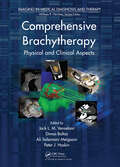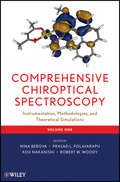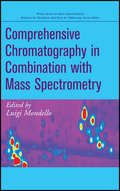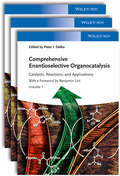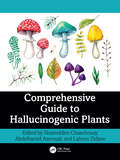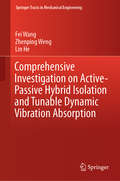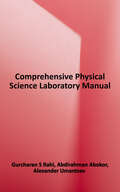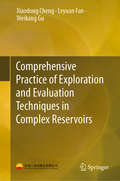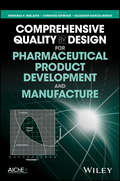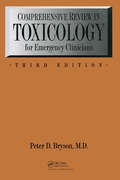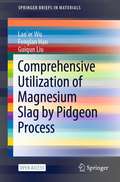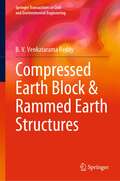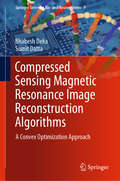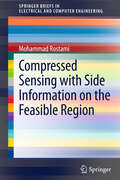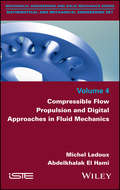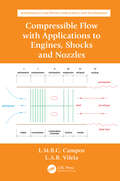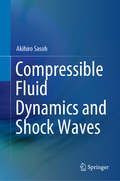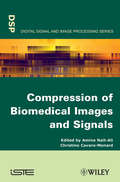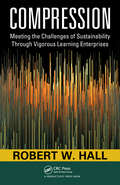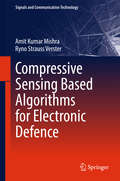- Table View
- List View
Comprehensive Brachytherapy: Physical and Clinical Aspects (Imaging in Medical Diagnosis and Therapy)
by Peter J. Hoskin Jack L. M. Venselaar Dimos Baltas Ali S. MeigooniModern brachytherapy is one of the most important oncological treatment modalities requiring an integrated approach that utilizes new technologies, advanced clinical imaging facilities, and a thorough understanding of the radiobiological effects on different tissues, the principles of physics, dosimetry techniques and protocols, and clinical expertise. A complete overview of the field, Comprehensive Brachytherapy: Physical and Clinical Aspects is a landmark publication, presenting a detailed account of the underlying physics, design, and implementation of the techniques, along with practical guidance for practitioners.Bridging the gap between research and application, this single source brings together the technological basis, radiation dosimetry, quality assurance, and fundamentals of brachytherapy. In addition, it presents discussion of the most recent clinical practice in brachytherapy including prostate, gynecology, breast, and other clinical treatment sites. Along with exploring new clinical protocols, it discusses major advances in imaging, robotics, dosimetry, Monte Carlo-based dose calculation, and optimization.
Comprehensive Chiroptical Spectroscopy, Applications in Stereochemical Analysis of Synthetic Compounds, Natural Products, and Biomolecules
by Nina Berova Prasad L. Polavarapu Robert W. Woody Koji NakanishiThis book provides an introduction to the important methods of chiroptical spectroscopy in general, and circular dichroism (CD) in particular, which are increasingly important in all areas of chemistry, biochemistry, and structural biology. The book can be used as a text for undergraduate and graduate students and as a reference for researchers in academia and industry. Experimental methods and instrumentation are described with topics ranging from the most widely used methods (electronic and vibrational CD) to frontier areas such as nonlinear spectroscopy and photoelectron CD, as well as the theory of chiroptical methods and techniques for simulating chiroptical properties. Applications of chiroptical spectroscopy to problems in organic stereochemistry, inorganic stereochemistry, and biochemistry and structural biology are also discussed, and each chapter is written by one or more leading authorities with extensive experience in the field.
Comprehensive Chiroptical Spectroscopy, Instrumentation, Methodologies, and Theoretical Simulations
by Nina Berova Prasad L. Polavarapu Robert W. Woody Koji NakanishiThis book provides an introduction to the important methods of chiroptical spectroscopy in general, and circular dichroism (CD) in particular, which are increasingly important in all areas of chemistry, biochemistry, and structural biology. The book can be used as a text for undergraduate and graduate students and as a reference for researchers in academia and industry, with or without the companion volume in this set. Experimental methods and instrumentation are described with topics ranging from the most widely used methods (electronic and vibrational CD) to frontier areas such as nonlinear spectroscopy and photoelectron CD, as well as the theory of chiroptical methods and techniques for simulating chiroptical properties. Each chapter is written by one or more leading authorities with extensive experience in the field.
Comprehensive Chromatography in Combination with Mass Spectrometry
by Luigi MondelloThis book provides a detailed description of various multidimensional chromatographic separation techniques. The editor first provides an introduction to the area and then dives right into the various complex separation techniques. While still not used routinely comprehensive chromatography techniques will help acquaint the readers with the fundamentals and possible benefits of multi-dimensional separations coupled with mass spectrometry.The topics include a wide range of material that will appease all interested in either entering the field of multidimensional chromatography and those looking to gain a better understanding of the topic.
Comprehensive Enantioselective Organocatalysis
by Peter I. DalkoA much-needed overview reflecting the developments over the past five years, this is the most comprehensive handbook on organocatalysis. As such, all relevant catalyst systems are discussed in detail, as well as key strategies, reaction types, and important applications in total synthesis. The first two volumes cover catalyst structures and fundamental activation types. These chapters allow readers to familiarize themselves with the relatively complex interactions that make organocatalytic reactions selective; to gain an insight into the most efficient catalyst types; and to understand the importance of physical parameters that influence reactivity and selectivity. Volume three is structured around reaction types, i.e. nucleophile additions to C=X and C=C bonds; Friedel-Crafts reactions, organocatalytic sigmatropic reactions, regioselective reactions and desymmetrization strategies, ring-forming reactions, multicomponent (domino) reactions, multicatalyst systems and the application of organocatalytic reactions in multistep synthesis are discussed. An appendix recollecting catalyst structures with the adequate cross-references to the corresponding chapters rounds off the book.With its contributions written by pioneers of the organocatalysis field, this book provides non-specialists with an introduction to the topic as well as serving as a valuable source for researchers in academia and industry searching for an up-to-date and comprehensive overview of this promising area of synthetic organic chemistry.
Comprehensive Guide to Hallucinogenic Plants (Exploring Medicinal Plants)
by Noureddine Chaachouay Abdelhamid Azeroual Lahcen ZidaneHallucinogens have been traditionally used to encourage spiritual growth, heighten perception, inspire personal development, or expand reality. Comprehensive Guide to Hallucinogenic Plants focuses on ethnobotanical aspects of hallucinogenic plant species, featuring history on how they were used in ancient societies, identifying chemical compounds, and explaining modern medicinal uses, as well as conservation initiatives. The book emphasizes the importance of understanding the cultural, countrywide, environmental, and scientific importance of these medicinal plants.Some of the 50 plants covered in this work include: ayahuasca, ginger, kanna, dream herb, iboga, peyote, canary broom, coral tree, catnip, wild rue, kava, mandrake, and golden angel's trumpet. Each chapter includes information on historical plant use and identification of chemical compounds, and explains modern medicinal uses. The text highlights the importance of studying, evaluating, and utilizing these plants not in isolation, but from a global perspective.Comprehensive Guide to Hallucinogenic Plants appeals to plant scientists, botanists, ethnobotanists, pharmacologists, and those with an interest in alternative or herbal medicine.
Comprehensive Handbook of Chemical Bond Energies
by Yu-Ran LuoUnderstanding the energy it takes to build or break chemical bonds is essential for scientists and engineers in a wide range of innovative fields, including catalysis, nanomaterials, bioengineering, environmental chemistry, and space science. Reflecting the frequent additions and updates of bond dissociation energy (BDE) data throughout the literat
Comprehensive Home Science class 10 - CBSE Board
by Anju ChauhanThe book "Comprehensive Home Science - Class X" by Anju Chauhan serves as an essential academic guide aligned with the CBSE syllabus. It is structured to holistically cover both theoretical and practical aspects of Home Science, ensuring a balanced learning experience. The book is divided into six units focusing on various topics like human growth and development, resource management, food safety, personal hygiene, meal planning, and textile care. Each chapter is enriched with diagrams, tables, and summaries to enhance understanding and retention. Practical exercises, thought-provoking questions, and MCQs help students prepare effectively for examinations. Key highlights include emphasis on conceptual clarity, integration of real-life applications, and alignment with NEP 2020 goals, such as fostering life skills, critical thinking, and ethical values. It addresses challenges in education by adopting a student-centered approach that balances academic rigor with flexibility in learning styles. The book not only aids in board exam preparation but also instills a foundation for practical knowledge in daily life management.
Comprehensive Home Science class 9 - CBSE Board
by Ms PoonamThe book Comprehensive Home Science for Class IX by Ms. Poonam serves as an educational resource aligned with the CBSE syllabus, introducing students to the foundational concepts and practical aspects of Home Science. It encompasses diverse topics such as the meaning and importance of Home Science, family dynamics, nutrition and health, cooking methods, safety at home, textiles and clothing, and the selection of fabrics and attire. Structured in eight units, it combines theoretical knowledge with practical applications, emphasizing real-life skills and scientific approaches for harmonious family and community living. Rich with illustrations, tables, and pointwise summaries, the book is designed for ease of understanding and quick learning, catering to both boys and girls to encourage balanced skill development and career opportunities in the field.
Comprehensive Investigation on Active-Passive Hybrid Isolation and Tunable Dynamic Vibration Absorption (Springer Tracts in Mechanical Engineering)
by Lin He Fei Wang Zhenping WengThis book discusses efforts to control the low-frequency vibration transmission of typical power equipment and pipeline systems of ships, exploring the use of active and passive hybrid vibration isolation and adjustable dynamic vibration absorption technologies. It also proposes an adaptive feed-forward control strategy and studies a distributed feed-forward control hardware system. In addition, the book presents a three-way dynamic vibration absorption theory used to design a pipeline-system adjustable dynamic vibration absorber, which offers a number of advantages, such as compact structure, easy assembly and disassembly, low power consumption, excellent vibration control effect and wide frequency band adjustable ability, etc. This book is a valuable resource for researchers and engineers in the fields of noise and vibration control, active control systems, active vibration isolation and adaptive dynamic vibration absorption.
Comprehensive Physical Science Laboratory Manual
by Alexander Umantsev Gurcharan S Rahi Abdirahman AbokorThis is a laboratory manual for a one-semester college physical science course. This manual aims to familiarize students with some of the fundamental concepts of physical science by providing the opportunity to experimentally test the theories and hypotheses of physics and chemistry discussed in the lectures. Conducting experiments and collecting data to test the validity of theories and laws requires a different set of skills than those required for success in lecture. The work done in the laboratory will augment the student’s understanding of the lecture material as well as provide them with the opportunity to become familiar with the basic experimental techniques. Laboratory sessions described by the guide are designed to provide a hands-on introduction to experimental methods of scientific investigation. Each one provides the practical knowledge necessary for a well-rounded understanding of physical science.
Comprehensive Practice of Exploration and Evaluation Techniques in Complex Reservoirs
by Xiaodong Cheng Leyuan Fan Weikang GuThis book covers exploration and evaluation practices for various types of complex reservoirs, and summarizes a series of practical and effective techniques and methods.For example, it shows how, by integrating multiple types of new logging technology, complex reservoir petrophysics evaluation can be performed using high-precision core experiment data and quantitative logging interpretation; and demonstrates how the technology of sporopollen assemblage and palynofacies analysis can improve the time precision of sequence stratigraphy and the quantitative study level of sedimentary facies, respectively. It discusses how reservoir lateral prediction and vertical resolution can be substantially improved by integrating fracture prediction and geostatistical inversion; and presents innovative log interpretation charts for the lithological identification of metamorphic rocks, e.g. GR-DEN crossplot and Impedance-Resistivity crossplot.To support the main content, the book features a wealth of high-resolution, thin- section images, quantitative illustrations of palynofacies composition, multi-property overlapping map set and quantitative tables. It offers an essential reference guide for researchers in geological exploration and evaluation, and will also appeal to a broad readership, from engineering technicians to advanced graduate students in related areas.
Comprehensive Quality by Design for Pharmaceutical Product Development and Manufacture
by Christine Seymour Salvador García-Munoz Gintaras V. ReklaitisCovers a widespread view of Quality by Design (QbD) encompassing the many stages involved in the development of a new drug product. The book provides a broad view of Quality by Design (QbD) and shows how QbD concepts and analysis facilitate the development and manufacture of high quality products. QbD is seen as a framework for building process understanding, for implementing robust and effective manufacturing processes and provides the underpinnings for a science-based regulation of the pharmaceutical industry. Edited by the three renowned researchers in the field, Comprehensive Quality by Design for Pharmaceutical Product Development and Manufacture guides pharmaceutical engineers and scientists involved in product and process development, as well as teachers, on how to utilize QbD practices and applications effectively while complying with government regulations. The material is divided into three main sections: the first six chapters address the role of key technologies, including process modeling, process analytical technology, automated process control and statistical methodology in supporting QbD and establishing the associated design space. The second section consisting of seven chapters present a range of thoroughly developed case studies in which the tools and methodologies discussed in the first section are used to support specific drug substance and drug-product QbD related developments. The last section discussed the needs for integrated tools and reviews the status of information technology tools available for systematic data and knowledge management to support QbD and related activities. Comprehensive Quality by Design for Pharmaceutical Product Development and Manufacture is an ideal book for practitioners, researchers, and graduate students involved in the development, research, or studying of a new drug and its associated manufacturing process.
Comprehensive Reviews in Toxicology: For Emergency Clinicians
by Peter D BrysonRevised and updated, this edition covers general principles of overdose management; the automonic nervous system, neurotransmitters and drugs; drugs used in psychiatry; cardiac drugs; agents that burn; gases and abnormal haemoglobin formation; the
Comprehensive Utilization of Magnesium Slag by Pidgeon Process (SpringerBriefs in Materials)
by Fenglan Han Lan'er Wu Guiqun LiuThis open access book introduces the harmless handling/recycling of magnesium slag , the process of magnesium silicothermic reduction (Pidgeon process)which the slag was produced, and . the magnesium resources, layout of the industry of the world. Examples and experimental data in this book are from the author group’s research programs, as well as the rencent researches in China. The book could provide precious reference to scientists and engineers in the field of recycling and environment friendly use of the industrial solid wastes. It could also be used for researchers and students who are interested in relevant field.
Compressed Earth Block & Rammed Earth Structures (Springer Transactions in Civil and Environmental Engineering)
by B. V. ReddyThe book focuses on low carbon construction materials such as stabilised compressed earth blocks (CEB’s) and rammed earth (RE). The content has been divided into four broad themes which includes an introduction to earth construction & stabilised earth, stabilised compressed earth blocks and masonry, stabilised rammed earth, and energy, carbon emissions, sustainability and case studies. It provides basic introduction to earthen materials and earthen structures, particularly with reference to the contemporary work on stabilised earth products for structural applications in buildings. The illustrations in the form of graphs, tables and photographs help the reader to get a grip over the CEB and RE construction. The book illustrates many case studies and examples of CEB and RE buildings. The knowledge on structural characteristics of CEB and RE especially with reference to the durability of such earthen products, and the structural design aspects is uniquely dealt. The embodied energy, embodied carbon, and the impact on construction sector touching upon sustainability of buildings is another unique feature of the book. This volume will be a useful guide for the research community, teachers, engineers, architects, building professionals, practicing engineers, students and individuals aspiring to build low carbon and sustainable buildings.
Compressed Sensing Magnetic Resonance Image Reconstruction Algorithms: A Convex Optimization Approach (Springer Series on Bio- and Neurosystems #9)
by Bhabesh Deka Sumit DattaThis book presents a comprehensive review of the recent developments in fast L1-norm regularization-based compressed sensing (CS) magnetic resonance image reconstruction algorithms. Compressed sensing magnetic resonance imaging (CS-MRI) is able to reduce the scan time of MRI considerably as it is possible to reconstruct MR images from only a few measurements in the k-space; far below the requirements of the Nyquist sampling rate. L1-norm-based regularization problems can be solved efficiently using the state-of-the-art convex optimization techniques, which in general outperform the greedy techniques in terms of quality of reconstructions. Recently, fast convex optimization based reconstruction algorithms have been developed which are also able to achieve the benchmarks for the use of CS-MRI in clinical practice. This book enables graduate students, researchers, and medical practitioners working in the field of medical image processing, particularly in MRI to understand the need for the CS in MRI, and thereby how it could revolutionize the soft tissue imaging to benefit healthcare technology without making major changes in the existing scanner hardware. It would be particularly useful for researchers who have just entered into the exciting field of CS-MRI and would like to quickly go through the developments to date without diving into the detailed mathematical analysis. Finally, it also discusses recent trends and future research directions for implementation of CS-MRI in clinical practice, particularly in Bio- and Neuro-informatics applications.
Compressed Sensing with Side Information on the Feasible Region (SpringerBriefs in Electrical and Computer Engineering)
by Mohammad RostamiThis book discusses compressive sensing in the presence of side information. Compressive sensing is an emerging technique for efficiently acquiring and reconstructing a signal. Interesting instances of Compressive Sensing (CS) can occur when, apart from sparsity, side information is available about the source signals. The side information can be about the source structure, distribution, etc. Such cases can be viewed as extensions of the classical CS. In these cases we are interested in incorporating the side information to either improve the quality of the source reconstruction or decrease the number of samples required for accurate reconstruction. In this book we assume availability of side information about the feasible region. The main applications investigated are image deblurring for optical imaging, 3D surface reconstruction, and reconstructing spatiotemporally correlated sources. The author shows that the side information can be used to improve the quality of the reconstruction compared to the classic compressive sensing. The book will be of interest to all researchers working on compressive sensing, inverse problems, and image processing.
Compressible Flow Propulsion and Digital Approaches in Fluid Mechanics
by Abdelkhalak El Hami Michel LedouxThis book aims to provide an efficient methodology of solving a fluid mechanics problem, based on an awareness of the physical. It meets different objectives of the student, the future engineer or scientist: Simple sizing calculations are required to master today′s numerical approach for solving complex practical problems.
Compressible Flow with Applications to Engines, Shocks and Nozzles (Mathematics and Physics for Science and Technology #11)
by Luis Manuel Braga da Costa Campos Luís António Raio VilelaCompressible Flow with Application to Shocks and Propulsion is part of the series "Mathematics and Physics for Science and Technology", which combines rigorous mathematics with general physical principles to model practical engineering systems with a detailed derivation and interpretation of results. Volume V presents the mathematical theory of partial differential equations and methods of solution satisfying initial and boundary conditions, and includes applications to: acoustic, elastic, water, electromagnetic and other waves; the diffusion of heat, mass and electricity; and their interactions. This is the second book of the volume. The first book of volume V starts with the classification of partial differential equations and proceeds with similarity methods that apply in general to linear equations with constant coefficients and all derivatives of the same order, such as the Laplace and Biharmonic equations, without and with forcing. The similarity solutions are also applied to Burger's non-linear diffusion equation. First-order linear and quasi-linear partial differential equations with variable coefficients are considered, with application to the representation of conservative/non-conservative, solenoidal/rotational and Beltrami/helical vector fields by one, two or three scalar and/or one vector potential in relation with exact, inexact and non-integrable differentials. The latter appear in the first and second principles of thermodynamics that specify the constitutive and diffusive properties of matter as concerns thermal, mechanical, elastic, flow, electrical, magnetic and chemical phenomena and their interactions. The book is intended for graduate students and engineers working with mathematical models and can be applied to problems in mechanical, aerospace, electrical and other branches of engineering dealing with advanced technology, and also in the physical sciences and applied mathematics. This book: Simultaneously covers rigorous mathematics, general physical principles and engineering applications with practical interest Provides interpretation of results with the help of illustrations Includes detailed proofs of all results L.M.B.C. Campos was chair professor and the Coordinator of the Scientific Area of Applied and Aerospace Mechanics in the Department of Mechanical Engineering and also the director (and founder) of the Center for Aeronautical and Space Science and Technology until retirement in 2020. L.A.R. Vilela is currently completing an Integrated Master's degree in Aerospace Engineering at Institute Superior Tecnico (1ST) of Lisbon University.
Compressible Fluid Dynamics and Shock Waves
by Akihiro SasohThis book offers comprehensive coverage of compressible flow phenomena and their applications, and is intended for undergraduate/graduate students, practicing professionals, and researchers interested in the topic. Thanks to the clear explanations provided of a wide range of basic principles, the equations and formulas presented here can be understood with only a basic grasp of mathematics.The book particularly focuses on shock waves, offering a unique approach to the derivation of shock wave relations from conservation relations in fluids together with a contact surface, slip line or surface; in addition, the thrust of a rocket engine and that of an air-breathing engine are also formulated. Furthermore, the book covers important fundamentals of various aspects of physical fluid dynamics and engineering, including one-dimensional unsteady flows, and two-dimensional flows, in which oblique shock waves and Prandtl-Meyer expansion can be observed.
Compression of Biomedical Images and Signals
by Amine Nait-Ali Christine Cavaro-MenardDuring the last decade, image and signal compression for storage and transmission purpose has seen a great expansion. But what about medical data compression? Should a medical image or a physiological signal be processed and compressed like any other data? The progress made in imaging systems, storing systems and telemedicine makes compression in this field particularly interesting. However, this compression has to be adapted to the specificities of biomedical data which contain diagnosis information. As such, this book offers an overview of compression techniques applied to medical data, including: physiological signals, MRI, X-ray, ultrasound images, static and dynamic volumetric images. Researchers, clinicians, engineers and professionals in this area, along with postgraduate students in the signal and image processing field, will find this book to be of great interest.
Compression: Meeting the Challenges of Sustainability Through Vigorous Learning Enterprises
by Robert W. HallCOMPRESSION: Meeting the Challenges of Sustainability Through Vigorous Learning Enterprises sounds a clarion that we cannot afford to ignore. Global crises are squeezing us from all directions. Mostly they have to do with not enough: not enough natural resources to maintain our standard of living, not enough carbon rich soil to grow crops enough to
Compressive Sensing Based Algorithms for Electronic Defence (Signals and Communication Technology)
by Amit Kumar Mishra Ryno Strauss VersterThis book details some of the major developments in the implementation of compressive sensing in radio applications for electronic defense and warfare communication use. It provides a comprehensive background to the subject and at the same time describes some novel algorithms. It also investigates application value and performance-related parameters of compressive sensing in scenarios such as direction finding, spectrum monitoring, detection, and classification.
